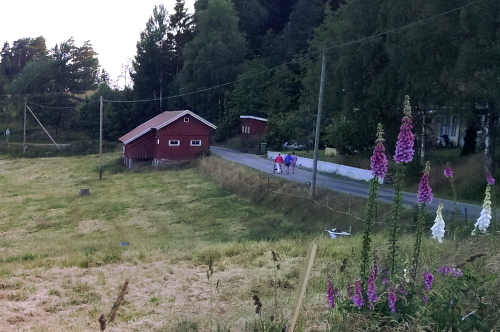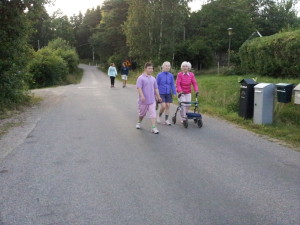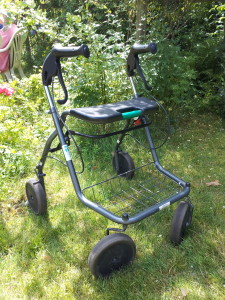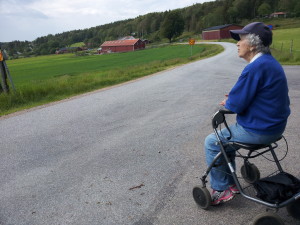I recently got back from vacation with some of my extended family, a really cool group of people between the ages of two and 92. At age 92, my grandmother still goes for long walks every day (that’s her in the picture below, in the pink jacket, with my mom and brother).
Prevention of injury and promotion of physical activity are two issues that can have mutual benefits but can also appear to be in conflict, as has been discussed in recent blog posts about sports safety. Nowhere does this seem more complex to me than the elderly population. Old age is often accompanied by reduced balance and brittle bones, increasing the risk – and the fear – of falls and fractures. Physical activity thus becomes more of a hassle and a hazard. But of course – physical activity also contributes to maintained bone density, even at moderate levels of physical activity (and can improve balance and muscle strength). In addition, there are of course numerous other health benefits to physical activity, including positive effects on mental health and cognitive ability. Regular exercise is recommended as a component of falls prevention in elderly. The authors of a meta-review note that walking seems to be the least efficient part of those programs, but that walking at a moderate pace (avoiding fast walking) still is valuable both as a component of falls prevention and for other health issues, as long as the walking can be done in a safe way.
This is not my area of expertise, but I’m interested because of Gran’s story. I have her permission to share this story and the photos – she says she is happy to share, if it can help others. If any of you readers are working in this field, please comment and let me know if I have missed or misunderstood anything important about this issue!
My Gran is very healthy for a 92-year old, and moves around with ease and a straight back. But three years ago, she had heart surgery. For a long time before the surgery, she had spells of fainting in public, something she remembers vividly. Once, she fell off the stairs of the bus and onto the sidewalk. (Thankfully with no serious injury, which she attributes to her habit of doing Chi Gong every morning, but that’s another story.) Despite this, she had been reluctant to start using walking aids, since she didn’t actually have any walking difficulties and didn’t want to seem more infirm than she was. (I haven’t found any research on this, but by experience I would think this is a common attitude. If you know of any research, please let us know!)
After surgery, she was at first weak-kneed and still afraid of losing her balance, but was encouraged by doctors to engage in regular physical activity. Feeling that she owed them to do her best, since they had chanced a heart surgery on an 89-year old, she accepted the walker-rollator*, the most common walking aid in Sweden, for using on walks (in addition to engaging in other, scheduled exercise activities). She has never regretted that decision, and is very fond of her walking aid, and the freedom and safety it gives her.
Gran and her rollator now go for long walks every day. She has learned to walk with a straight back also with the rollator – placing both hands on the handles, which are adjusted to her height. She even gets compliments from strangers on how beautifully straight-backed she walks with the rollator. She is no longer afraid of falling, and has a high confidence in her own walking fitness and independence. She insists on her daily walks, feeling that if she fails them, her health will suffer.
Gran’s rollator, as most Swedish rollators, has four wheels, hand brakes, a basket at the front lower end and a little “bench” to sit on.
On the little basket she can carry home the groceries – or bring an extra jacket for herself or for a grandchild. When she gets tired, she finds a spot off to the side, applies the brakes and sits on the bench for a while. Thus, she also decreases the risk of falling from fatigue. At home, she walks with one of her best friends, at least one hour per day, and when they get tired, they sit down on their rollators and talk over a cup of coffee – which they bring in a thermos in the rollator’s basket. During vacation, she walks alone or with children, grandchildren and great-grandchildren. For Gran, the rollator is her enabler of these walks, and she praises the benefits of the rollator and encourages others in her situation to start using one.
A walking aid is often seen as a sign of age or infirmity. But a study shows that for people over 75, walking with a rollator can be considered moderate to high intensity physical activity, enough to improve aerobic fitness. Thus, I see the walker-rollator as a sign of an active – and safe – senior.
* I was unsure what the correct term in English is, but after a quick scan of the Internet I think a walker-rollator is the best term for the four-wheel walker.
All photos are taken by me, and published with permission of family members who are in the photos.



